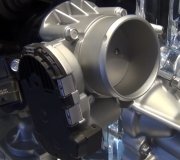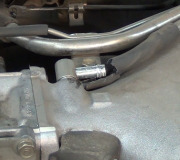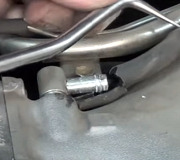There's no such thing as an idle sensor. What you're referring to is the automatic idle speed motor, (AIS). It is a "stepper" motor meaning the armature doesn't spin like in a normal motor and it doesn't have brushes. It is simply four electromagnetic coils that are pulsed with varying voltages and polarities to place the armature in one of 256 positions, called "steps". As the armature turns, a threaded shaft extends or retracts a pintle valve. As it retracts, it opens an air passage around the throttle blade. That lets more air in. At the same time the Engine Computer holds the injectors open longer during each pulse to let more fuel in. Idle speed is controlled by adjusting the amount of air and fuel going in.
You have two symptoms that likely have a common cause. The problem is either one could cause the other. If you raise engine speed just a little and it starts running smoothly, you likely just have a low idle speed problem. If it still runs rough, the low idle is likely caused by the misfire and that should be addressed first.
To tell if the idle speed motor is working, observe what happens to engine speed when you start it. The idle speed should flare up to 1500 rpm, then come back down to around 800 rpm within a few seconds. If that doesn't happen, you typically will have two other symptoms. You'll need to hold the accelerator down about 1/4" to get the engine started, and the engine will tend to stall at stop signs due to low idle speed.
There's two causes for low idle speed. One is that air passage gets plugged with carbon so no extra air can get through. That was a big problem on some engines many years ago, but with the better additives in today's gas, we don't see much of that anymore. The more common cause on Chrysler products occurs after the battery is disconnected or run dead. The Engine Computer loses its memory and has to relearn "minimum throttle" before it will know when it has to be in control of idle speed. To meet the conditions for that relearn to take place, drive at highway speed with the engine warmed up, then coast for at least seven seconds without touching the pedals.
When the idle speed goes up and down, there's again two things to consider. One is the idle speed motor is staying steady at a specific step, and something else is causing a variation in the amount of fuel going into the engine. The other is the idle speed motor is being moved by the Engine Computer in response to something it is seeing from the sensors. The first one can be caused by a misfiring spark plug, old gas, or a vacuum leak. The second one can also be caused by the computer responding to the increased engine speed caused by that vacuum leak, or an erratic reading from some other sensor.
Your mechanic will connect a scanner to view live data and see what the computer is seeing and responding to. He can also get an idea of what's happening by watching those idle steps. Step 32 is typical for a properly running engine. With one spark plug misfiring, the computer will put the AIS motor at about step 50 to maintain proper idle speed. When the idle speed is varying a lot, you have to determine if the AIS steps are causing the idle speed to vary, or if the idle speed is varying and the computer is adjusting the AIS motor in an attempt to correct the speed. One way to tell is to unplug the AIS motor. That will set a diagnostic fault code and turn on the Check Engine light, but since it can't move, the idle speed can't be adjusted. If it does still vary, there is some other condition causing it that needs to be diagnosed. If the engine speed holds reasonably steady, it was varying due to something the computer was reacting to. That's where watching the sensors' readings on the scanner is useful. A vacuum leak usually shows up as a lean condition from the oxygen sensor. A cylinder misfire can usually be heard and felt. An intermittent coolant temperature sensor will cause intermittent changes in idle speed. That was real common on Ford products. A map sensor that's starting to fail can provide erroneous readings that make the computer calculate the wrong amount of fuel. That usually results in pretty big swings in engine idle speed, and those sensors rarely take more than a day or two to fail completely.
SPONSORED LINKS
Wednesday, September 10th, 2014 AT 4:11 PM




